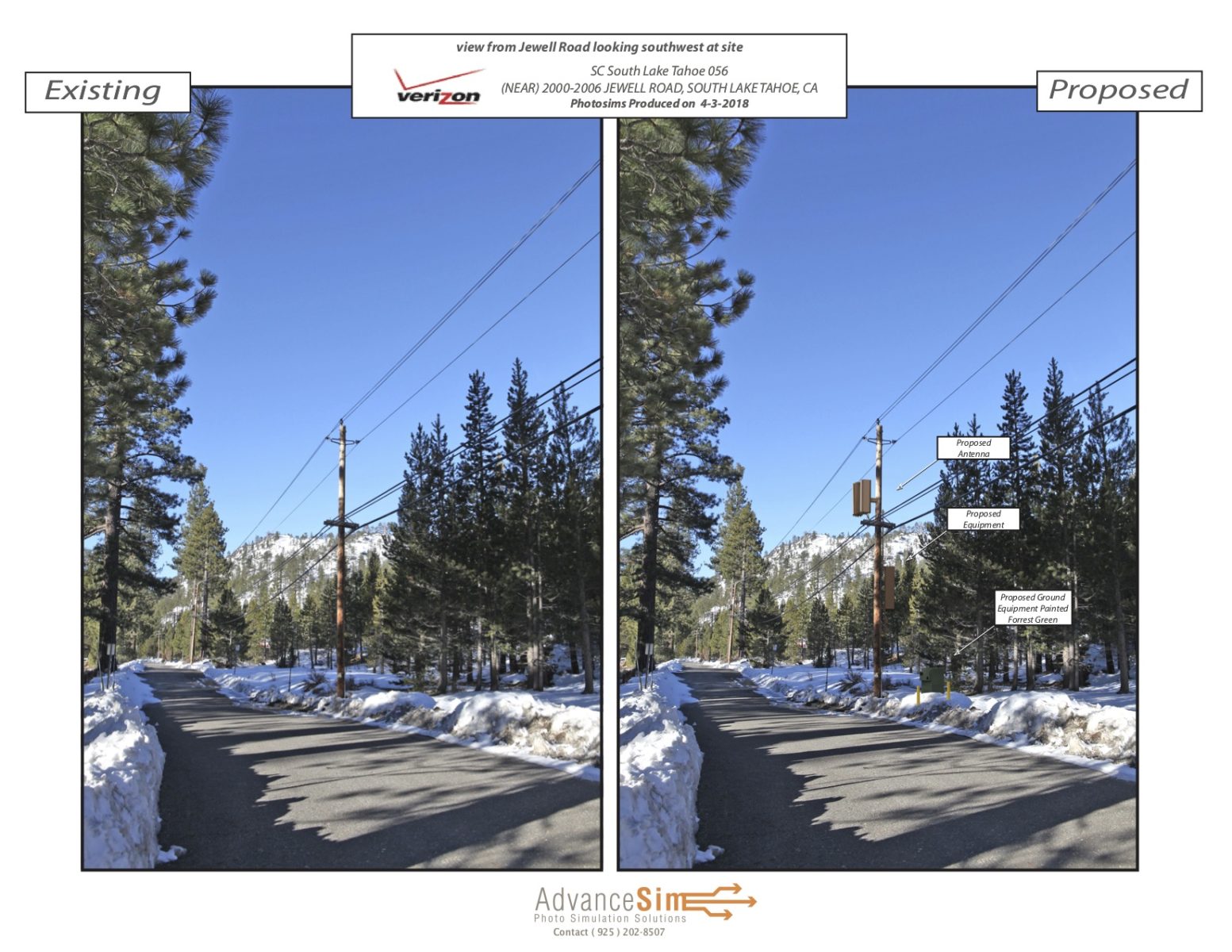How Is Verizon Cell Service In South Lake Tahoe
How does this
affect me?
This affects you if you rely on cell phones to connect with your family, friends, or work. It affects you if you use your cell phone during emergencies or just to look up directions or local businesses. This is your opportunity to get better wireless service for you and your neighbors.
All Lake Tahoe residents benefit from improved Verizon Wireless service, even non-Verizon Wireless customers. These new proposed installations will dramatically improve the ability of the Verizon network to handle future cellular and broadband demands for businesses, individuals and first responders who utilize this system, in addition to providing a critical backup to traditional landlines during power outages.
First, the small cell network will relieve congestion on the Verizon Wireless network serving Lake Tahoe by providing additional capacity to address demands for service. This added capacity improves Verizon Wireless's network for all of Lake Tahoe by off-loading calls and data demands from existing facilities. Second, these enhancements will improve network service for Lake Tahoe first responders. Finally, should another wireless carrier's network fail, the Verizon Wireless network is available to all users for emergency calls and text messages.
Lake Tahoe first responders leverage the Verizon Wireless Network for vital communications across a broad range of emergency situations from patient treatment coordination between ambulance EMTs and hospital emergency rooms, to protecting officers in the field by providing vital off-radio channels for police work. Additionally, cellular service is vital during extreme weather, natural disasters or other unforeseen events that may lead to road closures and power outages. Verizon understands the importance of being able to communicate with loved ones and emergency services in times of crisis. Therefore, Verizon Wireless has or will install a standby backup battery to insure quality communication for the Lake Tahoe and surrounding communities, regardless of any widespread power outages.
At home, the Verizon Wireless Network is leveraged for more than staying connected with friends and family or entertainment online. The Network supports home security monitoring, connectivity for home health monitoring devices or even tracking a lost pet.
90% of US households use wireless service. With this increase in demand from users at home and those who work from home comes the need for more facilities to meet the customer needs. Citizens need access to 911 and reverse 911 and wireless may be their only connection. (CTIA, June 2015)
The wireless future is here with small cells.
To stay ahead of demand, Verizon is deploying new technology, commonly referred to as small cells. A small cell network adds coverage, capacity, and increases connection speed so that more users can connect to reliable high-speed wireless service where they live, work and play. Small cells are part of a macro-micro cellular communication coverage umbrella enabling information flow between traditional cell sites and small cells. This architecture provides a higher quality of service and increased capacity to a dedicated geographic location. Small cell architecture enhances the network for users in the selected geographic small cell area. The increased communication quality benefits customers during normal communication use and emergencies.
Small cells are a fraction of the size of traditional communication facilities, use a fraction of the power and serve a much smaller area than traditional cell sites. The reduced size allows the small cells to attach to existing utility poles and light standards.

Improved Service
Since the launch of the smartphone more than 10 years ago, Verizon Wireless has been introducing new technologies to meet service capacity demands. Today, reliable service and in-building coverage are essential to the everyday lives of Lake Tahoe residents, commuters and workers. Over the past year, the demand for Verizon Wireless voice and data services has nearly doubled and network enhancements are required to keep up with this ever‐increasing demand. Maintaining a highly reliable, high-speed, high-capacity network is also critical to emergency communications. Lake Tahoe residents, commuters and workers depend on this reliability of the Verizon Wireless network, especially to communicate with emergency professionals during times of crisis – including police, fire, ambulance and hospital calls.
Photosimulations


Verizon's Response to COVID-19
Verizon understands the need to stay connected, especially in difficult times. Learn about how we're responding to COVID-19.
Click here to learn more about Verizon's COVID-19 customer relief efforts.
How we build America's largest and most reliable 4G LTE network.
Verizon uses a balanced approach to engineering the best possible network given the local community's needs.
Traditional, or macro cell sites, are most often the best choice for meeting coverage and capacity needs. Macro sites are traditional cell sites or towers that provide coverage to a broad area, up to several miles.
Wireless coverage may already exist in an area, but with data usage growth increasing exponentially each year, more capacity is needed.
To meet capacity demands, we need to add more wireless antennas closer to users and closer to other cell sites to provide the reliable service customers have come to expect from Verizon.

Support better wireless service by sending us an email
If you value improved wireless service in Lake Tahoe and you support Verizon Wireless's proposed network enhancements, we need to hear from you. To show your support and let your voice be heard, take a moment to send an email. You can click to select any of the sample messages or create your own.
Your Email
Attend a Virtual Meeting
When:
May 12, 2020 at 9:00 AM
Where:
Additional details about the virtual meeting, including how to attend, may be accessed by clicking here.
Project
Planner:
More info:
For more information, contact Verizon Wireless Representative, Cris Villegas at SupportWirelessNorthernCalifornia@verizonwireless.com.
Frequently Asked Questions
FAQ
1. What is a small cell?
A small cell is just like the name implies. Small cells are short range mobile cell sites used to complement larger macro cells (or cell towers). A small cell augments Verizon's capacity in a given area. It consists of a radio, antenna, power and a fiber connection. Small cells enable the Verizon network team to strategically add capacity to high traffic areas.
2. Why small cells?
Demand for wireless data services has grown 18-fold over the past 5 years. Small cells are part of Verizon's network strategy to provide reliable service and keep up with this booming demand for wireless data. Small cell networks add capacity in small specific areas to improve in-building coverage, voice quality, reliability, and data speeds for local residents, businesses, first responders and visitors using the Verizon Wireless network.
3. How does it work?
A small cell uses small radios and antennas placed on various types of poles like utility poles, street lights, or new poles in the public right-of-way. The coverage area can range from a few hundred feet to upwards of 1,000 ft. depending on topography, capacity needs, and more. This small focused footprint, within Verizon Wireless' network, supports the latest technology-enabled devices, allowing more consumers to do things like stream video or share photos on social media during events.
4. Where will these sites be located?
The proposed location of these new installations will be on existing Liberty owned transmission poles. No trees or other vegetation will be removed as a part of this installation. The pole(s) for this project were selected based on the ability of a given location to provide line of site communication with other facilities (either existing or planned) in the Verizon network. Other mitigating factors in the selection process include topography, elevation, tree cover, etc.
5. Does this replace the need for macro cell sites?
For Verizon, small cells are part of a balanced approach to network capacity. Verizon will continue to add traditional macro cell sites, expand its wireless footprint for increased capacity and coverage, and will keep investing in the things that keep its network running, even during times of disaster – battery back-up, generators, mobile cell sites, and more.
6. Where will Verizon add small cells?
Verizon looks to add small cells in areas ranging from urban centers to residential communities where there is a need for extra capacity to serve customers to stay ahead of the demand for wireless data. VZW has partnered with Liberty Power to collocate VZW equipment on Liberty owned utility poles. Advantages include Less visual impact, alleviates the need to construct new towers in the area, faster less-obtrusive construction process and timeframe since in most cases, we are utilizing existing poles that are located close to power sources. The improved wireless service to be provided by the small cell network circles from the California border on the northern shore along highway 28 South along the Western border of the lake along HWY 89 and follows 89 as it curves East following the Lakeshore to the California border. The small cell network will provide improved service for all communities along the north, west and south sides of the lake including Tahoe City, Kings Beach, Homewood, Tahoma, Emerald Bay, Tahoe Pines, Dollar Point, South Lake Tahoe and more.
7. Are small cells safe?
The Federal Communications Commission, in consultation with multiple federal agencies, sets federal government safety standards regarding small cells. Those standards have wide safety margins and are designed to protect everyone, including children, and were established after close examination of research that scientists in the US and around the world conducted for decades. The research continues to this day, and agencies continue to monitor it.
Scientists have studied potential health effects of RF emissions from cell phones for decades. Based on all the research, federal agencies have concluded that equipment that complies with the safety standards poses no known health risks. And advisers to the World Health Organization have specifically concluded that the same goes for 5G equipment. In fact, the RF safety standards adopted by the United States Federal Communications Commission (FCC) are even more conservative than the levels adopted by some international standards bodies.
FCC: The FCC provides information about the safety of RF emissions from cellular base stations on its website at: http://www.fcc.gov/oet/rfsafety/rf-faqs.html.
FDA: The Food and Drug Administration's Cell phone website.
EPA: The Environmental Protection Agency's overview of cell phone safety.
Have more questions? Reach out to us at supportwireless@verizonwireless.com.
How Is Verizon Cell Service In South Lake Tahoe
Source: https://improveyourwireless.com/tahoe/
Posted by: smithwhane1992.blogspot.com

0 Response to "How Is Verizon Cell Service In South Lake Tahoe"
Post a Comment